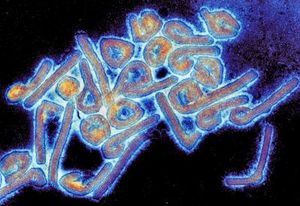Owl Evolution: Difference between revisions
| Line 1: | Line 1: | ||
==Introduction== | ==Introduction== | ||
Owls are known for their unique ability to see in the dark. This allows them to hunt when most other predators are sleeping, giving them a unique advantage. How did they evolve this ability, along with with their unique ability to move their necks close to 270 degrees, and their appearance?<br> | Owls are known for their unique ability to see in the dark. This allows them to hunt when most other predators are sleeping, giving them a unique advantage. How did they evolve this ability, along with with their unique ability to move their necks close to 270 degrees, and their appearance?<br> | ||
<br> | |||
Owls also have microbes that help them survive. These microbes | |||
<br><br> | <br><br> | ||
[[Image:marburgvirus.jpg|thumb|300px|right|Colony of Marburg virus. Transmission electron microscope image taken by Dr. Tom Geisbert]] | [[Image:marburgvirus.jpg|thumb|300px|right|Colony of Marburg virus. Transmission electron microscope image taken by Dr. Tom Geisbert]] | ||
Revision as of 01:02, 4 November 2019
Introduction
Owls are known for their unique ability to see in the dark. This allows them to hunt when most other predators are sleeping, giving them a unique advantage. How did they evolve this ability, along with with their unique ability to move their necks close to 270 degrees, and their appearance?
Owls also have microbes that help them survive. These microbes
At right is a sample image insertion. It works for any image uploaded anywhere to MicrobeWiki. The insertion code consists of:
Double brackets: [[
Filename: PHIL_1181_lores.jpg
Thumbnail status: |thumb|
Pixel size: |300px|
Placement on page: |right|
Legend/credit: Electron micrograph of the Ebola Zaire virus. This was the first photo ever taken of the virus, on 10/13/1976. By Dr. F.A. Murphy, now at U.C. Davis, then at the CDC.
Closed double brackets: ]]
Other examples:
Bold
Italic
Subscript: H2O
Superscript: Fe3+
Section 1 Genetics
Include some current research, with at least one image.
Sample citations: [1]
[2]
A citation code consists of a hyperlinked reference within "ref" begin and end codes.
Section 2 Microbiome
Include some current research, with a second image.
Conclusion
Overall text length should be at least 1,000 words (before counting references), with at least 2 images. Include at least 5 references under Reference section.
References
Edited by [Jaidyn Cook], student of Joan Slonczewski for BIOL 116 Information in Living Systems, 2019, Kenyon College.

